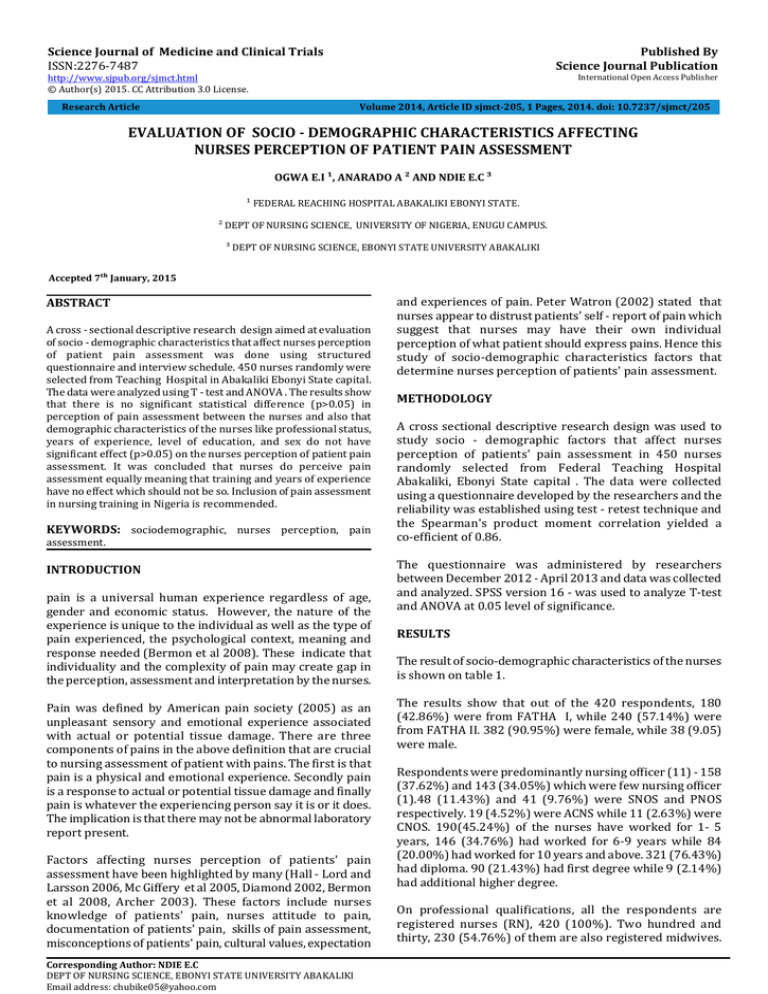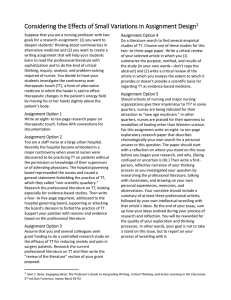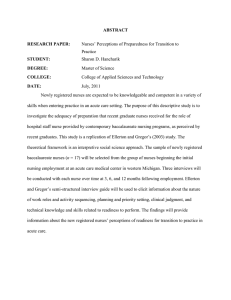ABSTRACT and experiences of pain. Peter Watron (2002) stated that
advertisement

Published By Science Journal Publication Science Journal of Medicine and Clinical Trials ISSN:2276-7487 International Open Access Publisher http://www.sjpub.org/sjmct.html © Author(s) 2015. CC Attribution 3.0 License. Research Article Volume 2014, Article ID sjmct-205, 1 Pages, 2014. doi: 10.7237/sjmct/205 EVALUATION OF SOCIO - DEMOGRAPHIC CHARACTERISTICS AFFECTING NURSES PERCEPTION OF PATIENT PAIN ASSESSMENT OGWA E.I ¹, ANARADO A ² AND NDIE E.C ³ ¹ FEDERAL REACHING HOSPITAL ABAKALIKI EBONYI STATE. ² DEPT OF NURSING SCIENCE, UNIVERSITY OF NIGERIA, ENUGU CAMPUS. ³ DEPT OF NURSING SCIENCE, EBONYI STATE UNIVERSITY ABAKALIKI Accepted 7�� January, 2015 ABSTRACT A cross - sectional descriptive research design aimed at evaluation of socio - demographic characteristics that affect nurses perception of patient pain assessment was done using structured questionnaire and interview schedule. 450 nurses randomly were selected from Teaching Hospital in Abakaliki Ebonyi State capital. The data were analyzed using T - test and ANOVA . The results show that there is no significant statistical difference (p>0.05) in perception of pain assessment between the nurses and also that demographic characteristics of the nurses like professional status, years of experience, level of education, and sex do not have significant effect (p>0.05) on the nurses perception of patient pain assessment. It was concluded that nurses do perceive pain assessment equally meaning that training and years of experience have no effect which should not be so. Inclusion of pain assessment in nursing training in Nigeria is recommended. KEYWORDS: sociodemographic, nurses perception, pain assessment. INTRODUCTION pain is a universal human experience regardless of age, gender and economic status. However, the nature of the experience is unique to the individual as well as the type of pain experienced, the psychological context, meaning and response needed (Bermon et al 2008). These indicate that individuality and the complexity of pain may create gap in the perception, assessment and interpretation by the nurses. Pain was defined by American pain society (2005) as an unpleasant sensory and emotional experience associated with actual or potential tissue damage. There are three components of pains in the above definition that are crucial to nursing assessment of patient with pains. The first is that pain is a physical and emotional experience. Secondly pain is a response to actual or potential tissue damage and finally pain is whatever the experiencing person say it is or it does. The implication is that there may not be abnormal laboratory report present. Factors affecting nurses perception of patients' pain assessment have been highlighted by many (Hall - Lord and Larsson 2006, Mc Giffery et al 2005, Diamond 2002, Bermon et al 2008, Archer 2003). These factors include nurses knowledge of patients' pain, nurses attitude to pain, documentation of patients' pain, skills of pain assessment, misconceptions of patients' pain, cultural values, expectation Corresponding Author: NDIE E.C DEPT OF NURSING SCIENCE, EBONYI STATE UNIVERSITY ABAKALIKI Email address: chubike05@yahoo.com and experiences of pain. Peter Watron (2002) stated that nurses appear to distrust patients' self - report of pain which suggest that nurses may have their own individual perception of what patient should express pains. Hence this study of socio-demographic characteristics factors that determine nurses perception of patients' pain assessment. METHODOLOGY A cross sectional descriptive research design was used to study socio - demographic factors that affect nurses perception of patients' pain assessment in 450 nurses randomly selected from Federal Teaching Hospital Abakaliki, Ebonyi State capital . The data were collected using a questionnaire developed by the researchers and the reliability was established using test - retest technique and the Spearman's product moment correlation yielded a co-efficient of 0.86. The questionnaire was administered by researchers between December 2012 - April 2013 and data was collected and analyzed. SPSS version 16 - was used to analyze T-test and ANOVA at 0.05 level of significance. RESULTS The result of socio-demographic characteristics of the nurses is shown on table 1. The results show that out of the 420 respondents, 180 (42.86%) were from FATHA I, while 240 (57.14%) were from FATHA II. 382 (90.95%) were female, while 38 (9.05) were male. Respondents were predominantly nursing officer (11) - 158 (37.62%) and 143 (34.05%) which were few nursing officer (1).48 (11.43%) and 41 (9.76%) were SNOS and PNOS respectively. 19 (4.52%) were ACNS while 11 (2.63%) were CNOS. 190(45.24%) of the nurses have worked for 1- 5 years, 146 (34.76%) had worked for 6-9 years while 84 (20.00%) had worked for 10 years and above. 321 (76.43%) had diploma. 90 (21.43%) had first degree while 9 (2.14%) had additional higher degree. On professional qualifications, all the respondents are registered nurses (RN), 420 (100%). Two hundred and thirty, 230 (54.76%) of them are also registered midwives. Science Journal of Medicine and Clinical Trials ( ISSN:2276-7487) page 2 Among the registered nurse/midwives, some of them possessed additional professional certificates in other nursing specialties as: intensive care nursing 5 (1.19%), Peri - operative nursing 12 (2.86%), Anesthetic nursing 10 (2.38%), Orthopedic nursing 2 (0.48%) and others 22 (5.24), respectively . Table 1: Socio-Demographic Characteristics of respondents. Gender distribution of participants: Males Females Total Professional status NO II NO I SNO PNO ACNO Number: 38 , 382 420 Percentage 9·05% 90·95% 100% 158 143 48 41 19 11 420 37.62 34.05 11.43 9.76 4.52 2.63 100% 190 146 84 420 45.24 34.76 20·00 100% 321 90 9 420 76.43 21.43 2.14 100% 420 230 5 12 10 2 22 100% 54.76 1.19 2.38 2.38 0.48 5.24 TOTAL Years of working experience 0f respondents: 1-5 6-9 10+ Total Highest academic attainment of respondents: Diploma First Degree Higher degree TOTAL Professional qualifications of respondents: RN RM ICU Peri-Operative Nurse Nurse Anesthetist Orthopedic Others (health education) Table 2: ANOVA RESULTS (a) Comparing the responses of the nurses perception of pain assessment according to their years of experience Sources of Variation Between Groups Within Groups significant Total Sum of Squares df Mean Square F P-Value Decision 0.035 3 0.012 0.073 0.974 Not 12·760 80 0.159 12.795 83 How to Cite this Article: Ogwa E.I, Anarado A and Ndie E.C, "Evaluation of Socio - Demographic Characteristics Affecting Nurses Perception of Patient Pain Assessment", Science Journal of Medicine and Clinical Trials, Volume 2014, Article ID sjmct-205, 1 Pages, 2014. doi: 10.7237/sjmct/205 page 3 Science Journal of Medicine and Clinical Trials ( ISSN:2276-7487) (b) Comparing the responses of the nurses on the academic qualifications of the respondents Sources of Variation Between Groups Within Groups significant Total Sum of Squares df Mean Square F P-Value Decision 0.197 5 0.098 0.479 0.622 Not 12·306 60 0.205 12.503 63 (c) Comparing the responses of the nurses on the academic qualifications of the respondents Sources of Variation Between Groups Within Groups significant Total Sum of Squares df Mean Square F P-Value Decision 0.643 5 0.129 0.456 0.808 Not 33·815 120 0.282 34.458 125 In comparing the response of the nurses perception of pain assessment according to their years of experience, there is no significant difference in their pain assessment (P>0.05); therefore, Ho is accepted. showed no significant difference in their perception of pain assessment (P>0.05); therefore, Ho is accepted. In comparing the responses of different ranks of nurses, there is no significant difference in their perception of pain assessment (P>0.05); therefore, Ho is accepted. The nurses' responses on the academic qualifications also Table 3: independent T-Test RESULTS (a) Independent t - test analysis showing nurses' perception of patients' pain assessment of FATHA I and FATHA II Hospital Mean Deviation Std FATHA I 3.68 9.01 FATHA II 4.13 9.21 Tcal 0·50 The data presented on table 3 revealed that the variables had a t-calculated of 0.50 with df of 418. There is no Df P-Value Decision 418 0.617 Not significant significant difference in the means rating of nurses of FMC and EBSUTH (P>0.05); therefore the Ho is accepted. (b) Independent t-test analysis of male/female nurses of EBSUTH and FMC Hospital Male Mean Deviation Std 3.58 9.01 Tcal 0·349 Female 4.14 Df P-Value Decision 418 0.727 Not significant 9.2 The data presented on table 3 showed that the value of t-calculated is 0.0349 with df of 418. There is no significant difference in the perception of patient' pain assessment of male and female nurses of FMC and EBSUTH (P>0.05); therefore, the Ho; is accepted. DISCUSSIONS This result examined the socio-demographic characteristics of nurses that affect their perception of product from assessment. The result indicated that hospital setting, years How to Cite this Article: Ogwa E.I, Anarado A and Ndie E.C, "Evaluation of Socio - Demographic Characteristics Affecting Nurses Perception of Patient Pain Assessment", Science Journal of Medicine and Clinical Trials, Volume 2014, Article ID sjmct-205, 1 Pages, 2014. doi: 10.7237/sjmct/205 Science Journal of Medicine and Clinical Trials ( ISSN:2276-7487) of experience, academic qualification, rank and gender of nurses do not have significant (p>0.05) effect on the nurses perception of patient pain assessment These nurses do not have the some level of knowledge, training, skills yet their perception were the same. This do not agree with McGiffery et al (2005); Berman et al (2008) and Hall -Lord and Larsson who were at the opinion that knowledge, skills and past experiences of the nurse affect nurses perception of patients' pain assessment. This result may be due to the level of knowledge about pains important to nurses during their training in Nigeria service what all the nurses have in common is their training being in Nigeria. CONCLUSION Page 4 3. Bermon, S., Snyder, S.J, Kozier, B. And Erb, G. (2008) Fundamentals of Nursing Concepts, Process and Practice, New Jersey. Pearson Prentice Hall. 4. Hall - Lord M,L Larsson B. (2006) Registered Nurses and Student Nurses Assessment of Pain and Distress Related to Specific Patient and Nurse Characteristic. Nurse Education Today, 26(5), 377 - 388. 5. McCoffery, M. And Ferrel B. (2005): Pain Management: Cognitive Restructuring as a Model For Teaching Nursing Students. Nurse Educator 30(5) 226 - 230. 6. Peter E. And Watson J. (2002): unrelieved Pain: an Ethical and Epistemological Analysis of Distrust inPatientsw. Canadion Journal of Research, 34 (2) 65 - 80 It can be concluded from the study that Nurses do not really understand the use of pain assessment tools and that indicates that they do not use it. RECOMMENDATIONS It is recommended that further studies should be conducted to identify the practice of pain assessment and instrument of pain assessment used by Nurses. ACKNOWLEDGEMENT We here by Acknowledge those Nurses who accepted to participate in this study by filling the questionnaire. REFERENCES 1. American Pain Society (2005) Principles of Analgesic Use in the Treatment of Acute and Cancer Pain. Glenview IL Author. 2. Archer C. (2003): Evaluation of the use that is made of Philosophy, Knowledge and Theory within the Area of past operative Pain Management. International Professional Nursing Journal, 3(1), 135 - 138 How to Cite this Article: Ogwa E.I, Anarado A and Ndie E.C, "Evaluation of Socio - Demographic Characteristics Affecting Nurses Perception of Patient Pain Assessment", Science Journal of Medicine and Clinical Trials, Volume 2014, Article ID sjmct-205, 1 Pages, 2014. doi: 10.7237/sjmct/205





